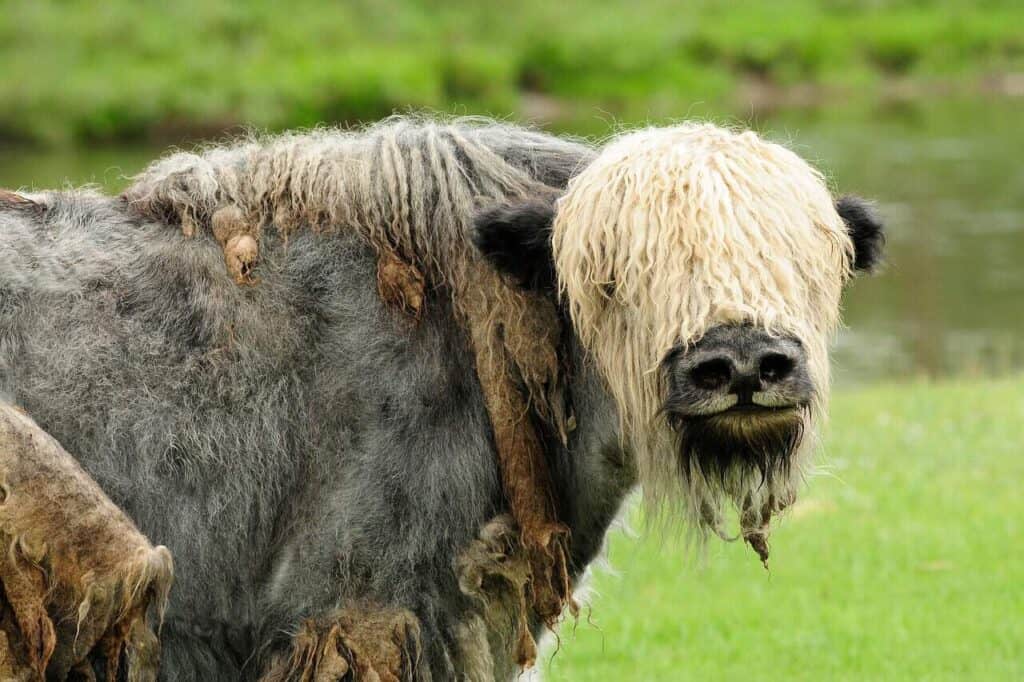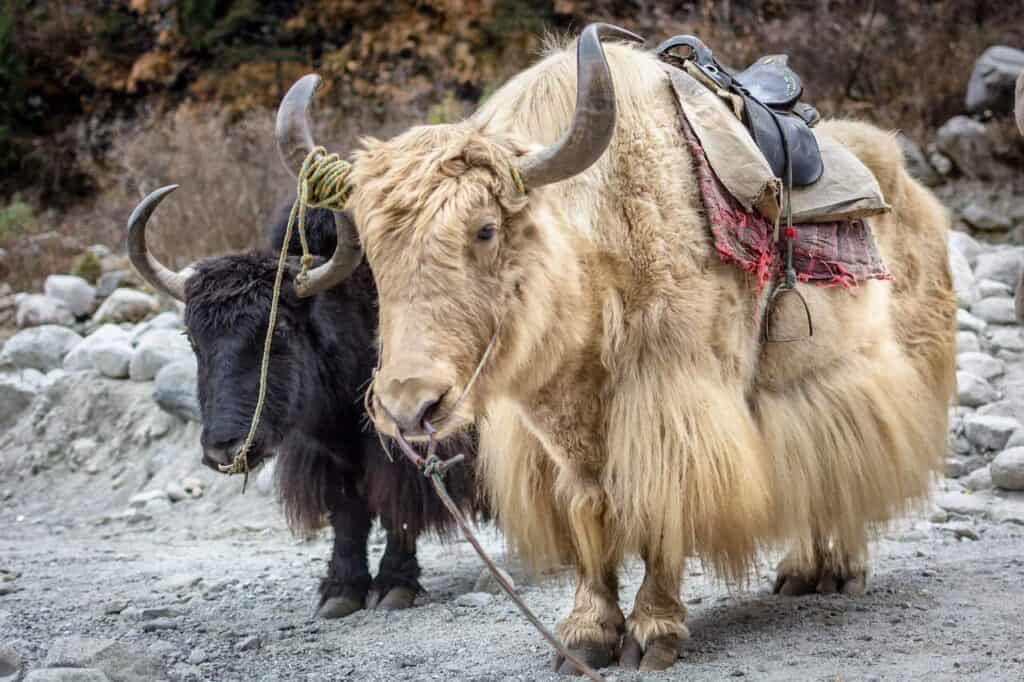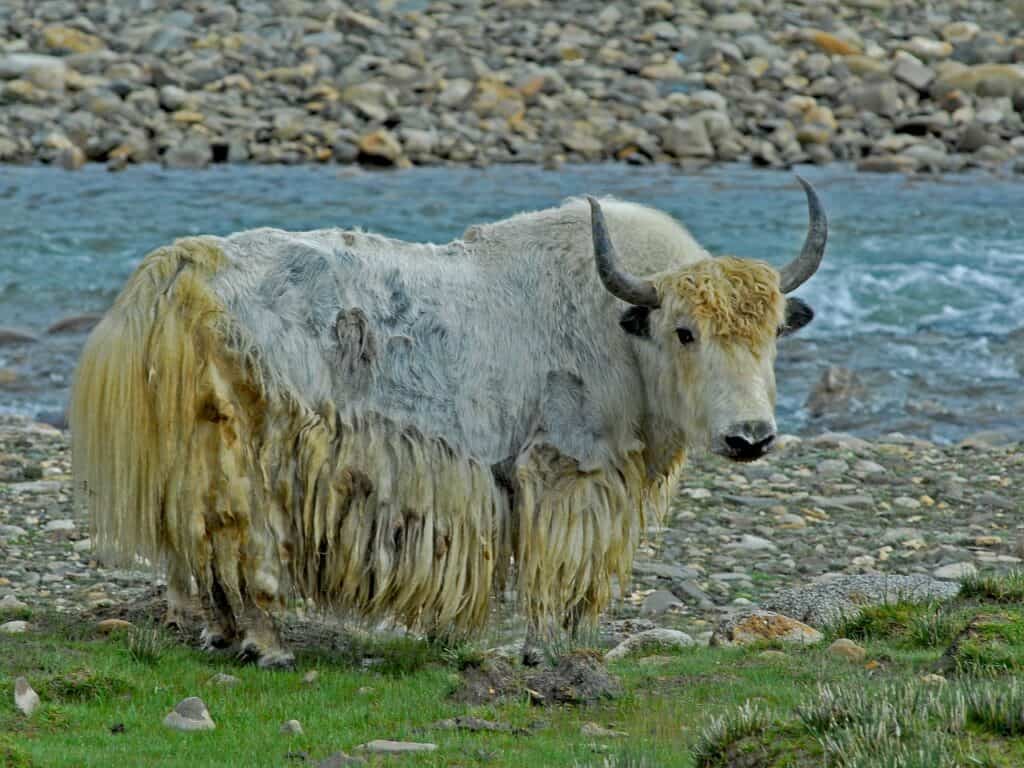- Unraveling the Mysteries of Yaks and Enticing Yak Fiber: Everything You Need to Know
Unraveling the Mysteries of Yaks and Yak Fiber: Everything You Need to Know
Yaks Facts and Husbandry

This deep dive on yaks and yak fiber is part of the Animal Fiber Encyclopedia
Special Thanks to Deep Draw Yak Ranch, for supplying fiber and allowing me to get footage of their sweetheart yaks!
- Names – Animal- Yak, Tartary ox, grunting ox, hairy cattle, Tibetan yak, and B. grunniens. Fiber – Khullu (down)
- Species and Breed: Yaks or Bos grunniens are part of the Bovidae family and are related to cattle and bison. There are several different breeds, Jiulong Yaks are specifically known for their fiber production. Zhongdian, Jiulong or Alpine, Maiwa, Gannan, Pali, Sibu, Huanhu, Bazhou, Plateau, Menyuan (county), and the Tianzhu White. Currently, the importation of yaks and yak embryos is heavily controlled so not all breeds are currently accessible.
- Historic roles – Yaks have historically worked pulling plows and for threshing. Yak work as pack animals and they can be ridden. Yak produces lean, high-protein meat that is low in saturated fat and high in omega 3s. Yaks also produce high-fat milk. Yak wool, or Khullu, is a luxury fiber.
- Animal Origin and History – Yaks are native to Central Asia, most notably in the areas of Tibet, Nepal, Northern India, and the steppes. Yaks are believed to have been domesticated around 10,000 years ago by the Qiang people of Tibet. While many think of Tibetan yak and Mongolian yak as separate yak types, there is no significant distinction among wild yaks. Large-scale hunting in the 1800s devastated the wild populations.
- Natural Range and Climate Needs – In the past the range of wild yaks reached from Siberia, the Tibetan Plateau to the Himalayas. They can survive extreme cold and high altitudes. Fully adapted to cold weather, they have almost no sweat glands. As a result, they can have difficulty in hot humid environments.
- Nutritional Needs: Yaks are ruminants. They eat grass and herbs. They are known to be gentle feeders and do not tear up the roots of grasses like other livestock. Yaks are also efficient feeders and require less grass or hay than the same number of cattle. Yak have a unique biome that leaves their droppings odorless. For best yak fiber growth, ensure adequate protein intake.
- Housing and Shelter: While Yaks have evolved in extreme conditions, they still can benefit from shelter. In areas with warmer temperatures, shaded areas will keep animals more comfortable and will limit the risk of overheating. In colder areas, especially those that are windy and wet, a shelter with two sides will allow yaks to conserve food energy for meat and fiber production. Removing burr-producing plants from yak pastures will also improve fiber yields and quality.
- Health and Veterinary Care: Yaks are vulnerable to most cattle diseases and parasites. Worldwide, yaks are vulnerable to hoof and mouth disease. Importing of yak, embryos, and yak fluids is very limited to prevent the spread of that pathogen. There has been a reported case of yak contracting the deer infection Epizootic Hemorrhagic disease (EHD). Symptoms for EHD are similar to hoof and mouth disease so careful monitoring and testing is important to prevent the spread.
- Reproduction and Breeding: Yaks are a summer breeder. Yaks reach sexual maturity between 6 and 8 years old. Their gestation lasts for nine months. Females usually deliver a single calf and calves nurse for a year. Following weaning females will be ready to be ready to breed again. While females can go into oestrus as many as four times in 12 months, they are only receptive for a few hours. Yaks grow more slowly than cattle, but they also live longer with and average life span of 30 years.
- Behavior and Social Structure: Yaks are herding animals and do best when kept in groups. Female groups are led by a dominant matriarch. Males are kept in separate groups except during breeding. They do have a herd hierarchy and can be aggressive to other members of the herd, but are generally docile with people. Females can be protective if they have young calves. Yaks are playful, gentle, and easy to train.
- Handling and Transportation: Like other Bovines, Yaks require squeeze chutes for safe close inspection and veterinary procedures. Because of their gentle nature, they can also be brushed or groomed in a more open atmosphere. They are best transported as with cattle, in a livestock trailer.
- Waste Management and Environmental Impact: Yak manure is notable for its lack of odor. Tibetan households have a long history of using Yak dung as a fuel. It has a unique place in Tibetan culture and is used for celebrations like weddings and other important ceremonies like funerals. While the burning of Yak dung has come under fire as polluting, current solutions are not cost-effective for impoverished villages and herders where dung can be had for free. Yak dung does compost well.
- Market Considerations: As of early 2024, Google Trends reflects a growing interest in both yak meat and yak wool, with meat having the edge in terms of interest. In 2023 CNN ran a video feature on Yak wool being the new cashmere, citing yak as more sustainable than goat herding. Ranchers in Iowa, Wyoming, Kansas, and South Dakota are investing and promoting yak as healthy meat. There is plenty of growth potential here, but whether the public accepts yak remains to be seen.
- Ethical Considerations: While wild yak are endangered, domestic yak are estimated to number as high as 15 million. That’s excellent news as it means wild populations are in less danger of poaching, but it does limit the available land for wild yaks. Yak down is collected by raking their coat in the spring as it falls out. This does not cause the yak pain. See the video below.
- Grooming and Shearing: Seasonal raking is essential to collect down fiber as it is shed. Additional grooming can remove dirt, debris, and tangles from the fiber during the rest of the year. Yearling yak grows more down than adults, but it is difficult to collect this abundant fiber as it tends to felt without regular grooming.
- Fiber Processing and Marketing: Yak Khullu down often needs to be de-haired after it has been collected. Vegetable matter may be a problem depending on how yak pastures are maintained. Yak do not produce lanolin so it can be spun prior to washing. Washing will remove dirt, pollen, and other materials. Due to the fineness of the fiber care must be taken not to felt the fiber when washing it. Yak yarn and yak Khullu garments can be sold as luxury fiber items.
- Community and Education: For further information on Yaks, yak events, and buying yaks, go to the International Yak Association, The World Heritage Yak Conservancy, or USYaks a science-based registry.

Yak Fiber on Film
Yak Fiber Characteristics and Details
- Fiber Characteristics: Yaks produce three fiber types. Down – which is short with irregular crimp. Mid-type hair which is a larger thickness, longer than the down, with some large crimp and good luster. Coarse hair – which is much longer fibers than mid-type yak hair with no crimp, and strong luster. Yak down fibers have a natural warmth, wicks moisture, and are stronger than similar sheep wool fibers. Yak wool is particularly known for its softness.
- Static electricity – Yak fiber is less static producing than cashmere.
- Fiber Catagory – Luxury fiber
- Care Instructions – Yak wool can felt, but the hair scales on yak fiber sit very close to the shaft, making it less prone to felting and less likely to hold together as felt. It may be possible for some yak pieces to tolerate being traditionally laundered in cool water, best practices would be to hand-wash with mild soap in cool water with no agitation. Blot excess water with a towel and lie flat to dry or block (dry on a framework that gently stretches a garment into the proper shape). Or dry clean if you must.
- Off-Season Care – Protect Yak fiber through the summer by washing it and immediately storing it in an air-tight container.
- Allergy Concerns, prewash – May contain trapped pollen, grasses, and spores. Post-wash – Hypoallergenic
- Fleece Weight – Large variation ranging from 9lbs (4kg) to over 55lbs. (25kg) half of which is down fiber, according to the Food and Agriculture Organization of the United Nations. Different breeds and locations have a significant impact on fleece production. Younger animals produce significantly more down fiber than older animals. Some yearlings’ total coats consist of as much as 70% down and six-year-old Yaks, have as little as 20% down in their entire coat.
- Odor – prewash – minimal, a tiny hint similar to goat. Post-wash – None. Yak wool resists odors, allowing for a long-wearing time between washes.
- Staple Length – Down – 1.5″ (3.8cm) up to 1.8″ (4.6cm)
- Fiber Fineness – 14 to 16 microns for down (Khullu) fibers.
- Lock Structure – None. Yak fiber is shed undercoat and hair and does not maintain a lock structure. Directly from the animal, yak fiber is light and breezy. It can easily blow away with a gust of wind.
- Crimp – irregular
- Natural Color(s) – white, ivory, pale grey, light brown, red-brown, chocolate brown and dark brown. Browns are more common. Yak’s that have white facial markings will have lighter color undercoats, even if the guard hair is dark.
- Luster – Mild luster to matte on the down fibers.
- Dyeability – Yak fiber does not take dye well.
- Feltability – Yak wool can be wet felted, but due to the unique scale structure of the fiber it tends to not hold together as felt, particularly if it has been spun prior to wet felting. It will dry felt. In woolpainting, its short staple length would make for excellent shading and detail work.
- Fiber Prep – Raw down yak fibers must be de-haired if it is to be spun for the most luxurious result. Flick carded, or carded with fine cards works best. Overworking the fibers will create nepps quickly. Traditionally yak fiber is felted with guard hairs. Commercial yak roving and de-haired yak top is available for purchase.
- Spinning Recommendations – Use high-twist spinning to limit pilling and improve durability. If blended with silk, merino wool, bluefaced leicester, or other natural fiber, spinning from the fold may improve the retention of the shorter yak fibers.
- Halo – Yes Yak fibers form a halo in finished works.
- Ideal Uses – outer hair is suitable for carpets, rugs, rope, and even making tents. It is even used to make wigs. Yak yarn made from down fibers, Khullu, is best suited to luxury items worn close to the skin, like shawls, cowls, sweaters, or collars. Yak yarn is best suited to knitting projects to limit fiber waste. It would also do well in woven items that remained uncut, like scarves. Yak fiber is not a strong felter so it is less suitable for felted projects. It has may potential fiber art applications as well.
- Community Resources (Clubs, Associations, etc.) – USYaks has some information on Yak fiber.

References
Fibre production and hides. (n.d.). https://www.fao.org/3/AD347E/ad347e0f.htm#:~:text=The%20highest%20amounts%20are%20obtained,50%20percent%20is%20down%20fibre.
Robson, D., & Ekarius, C. (2011). The Fleece & Fiber Sourcebook: More than 200 fibers from animal to spun yarn. Storey Pub.
Parkes, C. (2009). The knitter’s book of wool: The ultimate guide to understanding, using, and loving this most fabulous fiber. Potter Craft.
Smith, B. (2014). Spinners book of fleece. Storey Publishing Llc.
